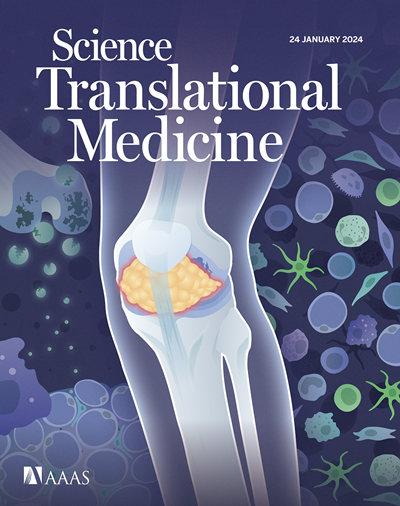BATF 是急性髓细胞性白血病中 NK 细胞表观遗传重编程和功能障碍的主要驱动因素
IF 15.8
1区 医学
Q1 CELL BIOLOGY
引用次数: 0
摘要
骨髓增生异常综合征和急性髓性白血病(AML)属于髓系恶性肿瘤的一种连续性疾病谱,在复发/难治的情况下预后较差,需要采用新型疗法。髓系恶性肿瘤患者的自然杀伤(NK)细胞表现出整体功能障碍,杀伤能力受损,新陈代谢改变,在单细胞转录组和蛋白质组水平上表现出衰竭表型。在这项研究中,我们发现这种功能障碍是通过 NK 细胞和髓样细胞之间的交叉对话介导的,而这种交叉对话需要细胞与细胞之间的接触。NK细胞功能障碍可通过靶向αvβ-整合素/TGF-β/SMAD通路来预防,但一旦形成,就会因深刻的表观遗传重编程而持续存在。我们发现 BATF 是一种核心转录因子,也是导致 AML 中 NK 细胞功能障碍的主要介质。从机理上讲,我们发现BATF直接受SMAD2/3调控和诱导,进而与NK细胞衰竭相关的关键基因结合,如HAVCR2、LAG3、TIGIT和CTLA4。删除 BATF 可增强 NK 细胞在体外和体内抗 AML 的功能。总之,我们的研究结果揭示了一种之前未被发现的NK免疫在AML中的逃避机制,这种机制表现为NK细胞的表观遗传重排和髓细胞瘤的失活。这项工作强调了使用健康的异体NK细胞作为治疗髓系恶性肿瘤患者的采纳性细胞疗法的重要性,同时还强调了通过靶向TGF-β途径或BATF来预防功能障碍的策略的重要性。本文章由计算机程序翻译,如有差异,请以英文原文为准。
BATF is a major driver of NK cell epigenetic reprogramming and dysfunction in AML
Myelodysplastic syndrome and acute myeloid leukemia (AML) belong to a continuous disease spectrum of myeloid malignancies with poor prognosis in the relapsed/refractory setting necessitating novel therapies. Natural killer (NK) cells from patients with myeloid malignancies display global dysfunction with impaired killing capacity, altered metabolism, and an exhausted phenotype at the single-cell transcriptomic and proteomic levels. In this study, we identified that this dysfunction was mediated through a cross-talk between NK cells and myeloid blasts necessitating cell-cell contact. NK cell dysfunction could be prevented by targeting the αvβ-integrin/TGF-β/SMAD pathway but, once established, was persistent because of profound epigenetic reprogramming. We identified BATF as a core transcription factor and the main mediator of this NK cell dysfunction in AML. Mechanistically, we found that BATF was directly regulated and induced by SMAD2/3 and, in turn, bound to key genes related to NK cell exhaustion, such as HAVCR2, LAG3, TIGIT, and CTLA4. BATF deletion enhanced NK cell function against AML in vitro and in vivo. Collectively, our findings reveal a previously unidentified mechanism of NK immune evasion in AML manifested by epigenetic rewiring and inactivation of NK cells by myeloid blasts. This work highlights the importance of using healthy allogeneic NK cells as an adoptive cell therapy to treat patients with myeloid malignancies combined with strategies aimed at preventing the dysfunction by targeting the TGF-β pathway or BATF.
求助全文
通过发布文献求助,成功后即可免费获取论文全文。
去求助
来源期刊

Science Translational Medicine
CELL BIOLOGY-MEDICINE, RESEARCH & EXPERIMENTAL
CiteScore
26.70
自引率
1.20%
发文量
309
审稿时长
1.7 months
期刊介绍:
Science Translational Medicine is an online journal that focuses on publishing research at the intersection of science, engineering, and medicine. The goal of the journal is to promote human health by providing a platform for researchers from various disciplines to communicate their latest advancements in biomedical, translational, and clinical research.
The journal aims to address the slow translation of scientific knowledge into effective treatments and health measures. It publishes articles that fill the knowledge gaps between preclinical research and medical applications, with a focus on accelerating the translation of knowledge into new ways of preventing, diagnosing, and treating human diseases.
The scope of Science Translational Medicine includes various areas such as cardiovascular disease, immunology/vaccines, metabolism/diabetes/obesity, neuroscience/neurology/psychiatry, cancer, infectious diseases, policy, behavior, bioengineering, chemical genomics/drug discovery, imaging, applied physical sciences, medical nanotechnology, drug delivery, biomarkers, gene therapy/regenerative medicine, toxicology and pharmacokinetics, data mining, cell culture, animal and human studies, medical informatics, and other interdisciplinary approaches to medicine.
The target audience of the journal includes researchers and management in academia, government, and the biotechnology and pharmaceutical industries. It is also relevant to physician scientists, regulators, policy makers, investors, business developers, and funding agencies.
 求助内容:
求助内容: 应助结果提醒方式:
应助结果提醒方式:


